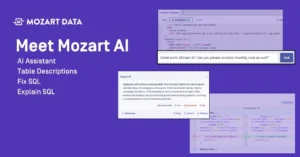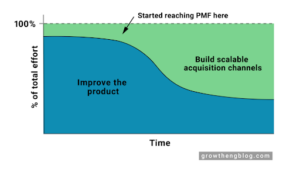As you work to build a modern data stack for your business, you may have heard that data transformation tools or a data transformation layer could help you work more efficiently with your data sets and better prepare them for analysis. This is true. A data transformation layer is an important component of a modern data stack. It enables a business to automate the validation and cleansing of data before it is used downstream, such as with a business intelligence tool. In this article, we’ll explain how a data transformation layer works within a modern data stack, the best data transformation tools, and how it all comes together within your business’s data strategy.

What is data transformation, and why is it important?
The raw data that is stored in the platforms in your tech stack is not analysis-ready. It may contain values that require calculations or concatenations before it can be used in a report or analysis. And it will inevitably contain flaws, such as duplicate values, invalid inputs, inconsistent formatting, etc. All these issues can be corrected through data transformation.
Without a data transformation tool in place, the task of transforming data typically falls to either a data scientist or data analyst. This is a time-consuming and error-prone process when completed manually, especially when it involves multiple data sets from a number of origin sources. The best data transformation tools, such as SQL queries, offer a more efficient and accurate approach. The only time a manual intervention would occur is if a spot-check error was discovered. In which case, the SQL query would simply be amended to correct the issue when running future data transformations.
How does a data transformation layer work within a modern data stack?
Data transformation is typically associated with ETL (extract, transform, load). ETL is a process that enables you to select the data you want to be extracted from your tech stack, organize it, and then load it into your data warehouse. A data transformation layer, however, is an additional tool that sits on top of your data warehouse. It allows you to query the data already stored in your data warehouse — for instance, in order to join values from select tables — and then validate and cleanse that data before it’s used downstream in a business intelligence tool.
Mozart Data’s modern data stack uses a data transformation layer that is built on a SQL editor, allowing our customers to write SQL queries. While some people prefer R, dbt, or Python, we chose SQL because it’s robust, yet relatively simple to use. This setup allows for automated data transformation so you can schedule your transforms in advance. And as your data grows, you can take advantage of incremental transforms to update just the data you need for your analysis, instead of processing a larger volume of data, which will run slower and increase compute costs.
How does data transformation fit within a data strategy?
Your business’s tech stack collects a large volume of data. It’s important to develop a data strategy that defines the tools, key people, and standard operating procedures (SOP) for working with that data. Your data strategy will have clear answers to these questions:
- What are the components of your modern data stack?
- How must the data be handled and processed as it moves from its origin and through the modern data stack, and by whom?
- Who defines the rules, oversees these workflows, and owns the SOP?
Once you create the framework for your data strategy, it’s time to set up your modern data stack. It’s best to think of it as an integrated platform instead of having separate parts. We’ve seen businesses do the latter — starting with one component and then filling in the gaps as they go — and it causes them to stumble through their data journey. Perhaps they learn about the value of a data warehouse and set up an account with Snowflake. Later they realize they need a good way to get data into their warehouse, so they reach out to Fivetran. Then they realize they need a transformation layer between their data warehouse and business intelligence tool to improve data quality and workflow efficiency. This piecemeal approach won’t save money and is slower to set up than creating an integrated modern data stack at the start.
The process of setting up a modern data stack doesn’t have to be time-consuming, and you don’t need a team of experts to assemble all of these individual tools. Mozart’s out-of-the-box modern data stack with built-in tech integrations enables you to get started immediately and at a fraction of the cost of alternatives. See the platform in action by scheduling a demo with us.


